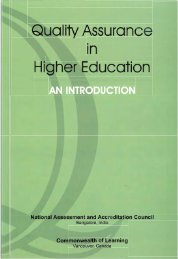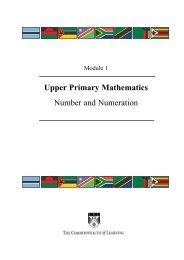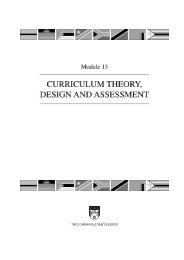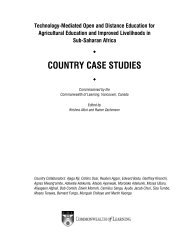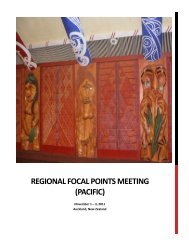Upper Primary Mathematics Fractions - Commonwealth of Learning
Upper Primary Mathematics Fractions - Commonwealth of Learning
Upper Primary Mathematics Fractions - Commonwealth of Learning
You also want an ePaper? Increase the reach of your titles
YUMPU automatically turns print PDFs into web optimized ePapers that Google loves.
Meaning <strong>of</strong> Common <strong>Fractions</strong><br />
To help pupils grasp the concept <strong>of</strong> common fractions, you should expose<br />
pupils to more than one definition. A common fraction may be looked at as a<br />
part <strong>of</strong> a whole, as an expression <strong>of</strong> division, or as a ratio.<br />
Fraction as a part <strong>of</strong> whole: a unit in the form <strong>of</strong> a continuous shape or as a<br />
discrete set is partitioned into equal sized parts.<br />
Fraction as an expression <strong>of</strong> division: if a woman walks 2 km per hour,<br />
5<br />
how many hours will it take to walk 5 km? She takes 5 ÷ 2 or hours.<br />
2<br />
a<br />
A fraction is another way <strong>of</strong> writing a ÷ b.<br />
b<br />
Fraction as an expression <strong>of</strong> ratios: ratios are expressions <strong>of</strong> a relationship<br />
between two quantities. If two out <strong>of</strong> five pupils are boys, then the ratio <strong>of</strong><br />
2<br />
boys to girls can be expressed as 2 to 5 or 2:5 or<br />
5<br />
. The fraction notation <strong>of</strong><br />
ratios is found in proportion.<br />
Fraction Models<br />
Besides the numerical interpretation <strong>of</strong> common fractions, you should use a<br />
variety <strong>of</strong> models such as area, length, and set models. As you go through<br />
this unit, think <strong>of</strong> other model presentations.<br />
Area Models<br />
Area models can be used to demonstrate visually that a fraction is part <strong>of</strong> a<br />
whole. Figure 1.1 illustrates a variety <strong>of</strong> area models.<br />
Circular "pie" pieces Rectangular regions<br />
Geoboards Drawings on grids or dot paper<br />
Pattern blocks Paper folding<br />
Figure 1.1: Area or region models for fractions<br />
Module 2: Unit 1 4<br />
Common <strong>Fractions</strong>



